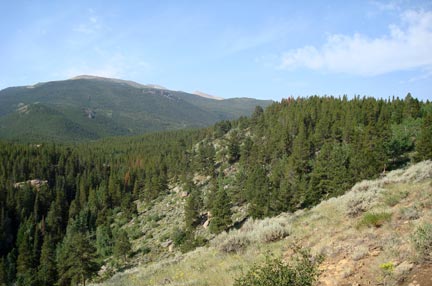
 |
The high-altitude view from a trail near the YMCA of the Rockies. |
High-altitude illness can affect anyone, no matter what age or fitness level. Visitors to the YMCA of the Rockies often notice shortness of breath and a faster heart beat, even with mild activities; some may also experience fatigue, dizziness, headaches, and nausea. It is essential to drink plenty of water (64 ounces daily), get lots of rest, and eat lightly to avoid side effects from the altitude. Take your time Because commercial jets are so fast, travelers today sometimes leave sea level and arrive at a high-altitude destination in one day -- too short a time for the body to acclimate. When you arrive in the Estes Park area, it will probably take several days for your body to adjust -- and the closer you live to sea level, the more time your body will need to get used to the altitude. Let your body acclimate when you get there, and take it easy for the first two days. If you can manage, you might plan on coming to Denver, Boulder, or Estes Park a day or two before the AUM conference so you can acclimate a little more gradually -- especially if you plan to do any active hiking. Symptoms of high-altitude illness Some of the first signs of high-altitude illness are headache, lightheadedness, weakness, trouble sleeping, and an upset stomach. If you are hiking and have some of these symptoms, stop going up -- descend to a lower altitude until your symptoms go away. If your symptoms are mild, rest until you feel better. Remember: mountains are vast and powerful, and very different from the sheltered environment we normally live in. Safety first! At 8,000 feet, more severe symptoms are likely to show up only with hiking or hard physical activity. These symptoms include difficulty breathing when exercising or even while resting, decreased urine output, coughing, confusion, and loss of coordination -- for instance, being unable to walk in a straight line. If you get these symptoms, go to a lower altitude immediately and seek medical attention. People who are experiencing high-altitude sickness may not be aware of it, or may deny that it is happening. Actively watch out for each other when hiking, be aware if a person becomes fatigued or complains of a headache, and take frequent rest breaks. Prevention A few simple precautions can make your stay in the mountains a pleasant one.
Who should not come to high altitudes It is not medically safe for everyone to be at high elevations. If you have any medical problems, especially those related to the heart and lungs, check with your physician before leaving home. For more information
<< Back to Safety |